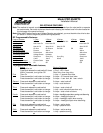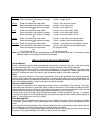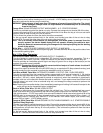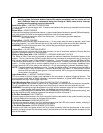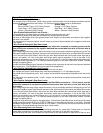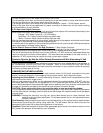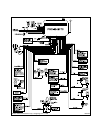
Page 3
Valet Switch:
Select a mounting location for the switch that is easily accessible to the driver of the vehicle. The switch
does not have to be concealed, however, concealing the switch is always recommended, as this provides
an even higher level of security to the vehicle.
The valet switch can be mounted to the lower side of the dash by drilling a ¼ " diameter hole in the selected
location.
Be sure to check behind the dash for adequate clearance for the body of the switch, and to confirm that the
drill will not damage any existing components as it passes through the dash. Route the two pin connector
toward the control module.
OPTIONAL Shock Sensor:
Select a solid mounting surface for the shock sensor on the firewall inside the passenger compartment,
and mount the sensor using the two screws provided. The shock sensor can also be secured to any fixed
brace behind the dash using tie straps.
Whichever mounting method is selected, make certain that the sensitivity adjustment is accessible for use
later in the installation.
WIRING THE SYSTEM
Large 10 Pin Edge Connector:
Red/White (5Amp) & Red (15Amp) Fused Wires: + 12 VDC Constant Battery Source
This wire controls the sensitivity of the voltage sensing circuit, which detects the turning on of an interior
light when a door is opened. It will also detect the switching on of parking or headlamps, and in many
cases will trigger the alarm when a thermostatically controlled electronic radiator cooling fan switches on.
When installing this system into vehicles with electronic "after fans", it is recommended you disable the
voltage sense circuit.
In voltage sensing applications, the closer to the battery that the red wire is connected, the less sensitive
the voltage sense circuitry will be. Moving this connection point to the fuse panel will increase the sensitivity,
and connecting to the courtesy lamp fuse in the vehicle will provide maximum sensitivity of the voltage
sense circuit. Be certain to set selectable feature # 7 to 1 chirp, Voltage Sense On.
When hardwiring the control module to pin switches at all entry points, the voltage sense circuit must be disabled.
White w/ Black Trace Wire: POSITIVE OUTPUT TO SIREN
Route this wire through a rubber grommet in the firewall, and to the siren location.
Connect the white / black wire to the positive wire of the siren. Secure the black ground wire of the siren to
chassis ground.
2 Dark Green w/ White Trace Wires: ENTRY ILLUMINATION
The dark green w/ white trace wires provide the entry lighting, and flash the vehicle’s dome light while the
alarm is sounding. These are NO ( normally open ) and COM ( common ) contacts of an on board, 10 Amp
maximum relay.
Connect one of the dark green w/ white trace wires to the wire in the vehicle that turns on the interior
courtesy light. Connect the other dark green w/ white trace wire to either chassis ground if the vehicle
switches ground to the courtesy lights, or a fused + 12 volt constant battery source if the vehicle switches
12 volts to the courtesy lights.
NOTE: When wiring this feature in vehicles with factory equipped delay lighting circuits, it is best
to connect to the output of the timer which feeds the dome light, rather than at the door
switch. This will ensure that the dome light pulses when the alarm is triggered.
Black Wire: CHASSIS GROUND
Connect this wire to a solid, metal part of the vehicle’s chassis. Do not confuse this wire with the thin black
antenna wire that exits the control module independently.
2 Dark Blue Wires: DELAYED PULSED OUTPUT / CHANNEL 3 (OPTIONAL DEVICE)
Typically Used For Remote Electric Trunk Release Operation, when activated, this output provides a
800ms closure of the on board relay.
The dark blue wires are controlled via an independent RF channel from the keychain transmitter. These
are the N.O. and COMMON contacts of an on board, 10 Amp relay, so they can be connected to positive
or negative switched circuits.



